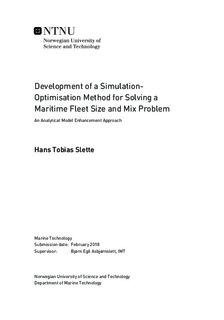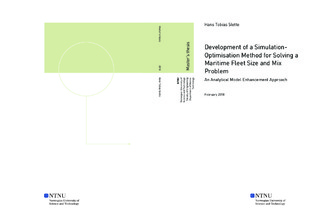| dc.description.abstract | This report describes the development of a simulation-based optimisation algorithm for solving a maritime fleet size and mix problem. The problem in question is a platform supply problem, identifying minimum cost fleets for reliably serving a number of offshore platforms from an onshore base. The simulation model for evaluating the different fleet compositions was provided by SINTEF Ocean through the ArcticLog-project, and it was treated as a black box.
A literature review was performed, covering solution methods for optimisation problems utilising simulation evaluation; (i) Mathematical Programming based methods, (ii) Direct Search methods and (iii) Simheuristics. The suitability of the different concepts was examined, with emphasis on flexibility and intuitiveness. Concept (iii) was selected; establishing an approximate analytic model for quick solution evaluations, and a combination of a Nested Partitions algorithm and a Genetic Algorithm directing the search process. Optimal Computing Budget Allocation, Intensification, and Variance Reduction Techniques were added to improve solution method efficiency.
The solution method was tested for several different cases, with varying mission sizes, the lists of possible vessel concepts, the number of platforms, and the characteristics of both the base and platforms. The results were promising; good solutions were found quickly, and the computation time increased linearly with respect to all relevant parameters. Also, the method was found to be flexible and intuitive. Thus, it can easily be applied to a range of problem variations, serving as a practical decision support tool.
Global convergence for the solution method is not proven, and no optimistic bound is established. Therefore, addressing these issues is recommended for further work. In addition, a more comprehensive assessment should be conducted on the effect of the different choices made in the implementation, and the usefulness compared to other methods. | |

